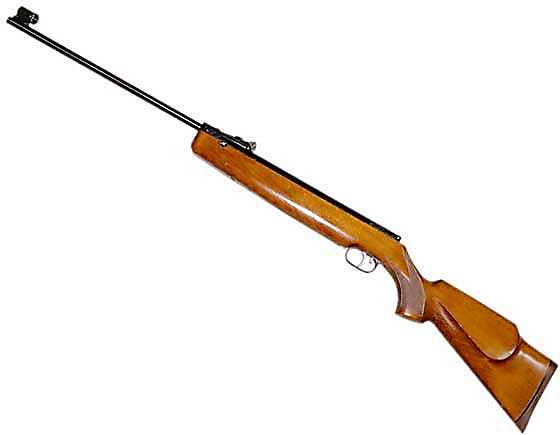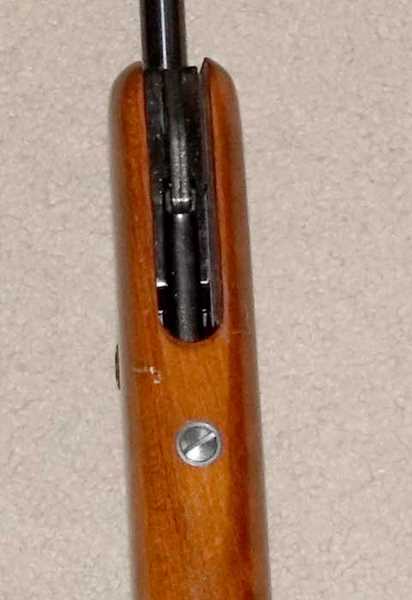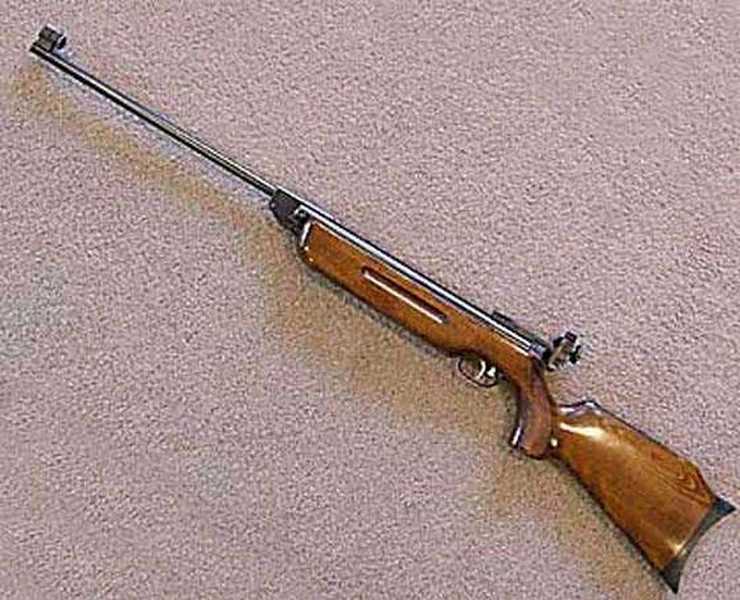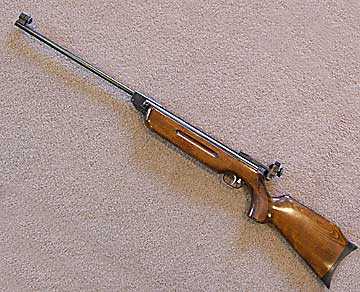by Tom Gaylord
Writing as B.B. Pelletier
This report covers:
- The beginning
- What is a lube tune?
- The rifle
- Initial impressions
- The plan
- History
- Summary
When talking about guns that become favorites, they say the airgun picks the shooter. Actually they say that about a lot of hobbies. This R8 certainly picked me — and then steamrolled me into submission!
The beginning
I was at the dinner/reception the evening before the 2017 Findlay airgun show last weekend when Tyler Patner and Kristen Coss from Pyramyd AIR walked in. I went over to say hello and Tyler asked me a question about an old airgun they had brought to sell. Actually they brought about 50 old guns and a lot of vintage Beeman pellets that they received in the purchase of a dealership. I asked to see the list and noticed a Beeman R8. That is an airgun I have never directly tested, though my Tyrolean breakbarrel that’s one of my all-time favorites started out as an R8. That one was tuned, and I always wondered what a standard R8 would be like, so I cut a deal for this rifle, sight unseen.
The next morning at the show we consummated the deal and I had a new/old R8. It was prettier than described, so I was pleased. What I didn’t know was I had just taken the leash of a lightning bolt!

My Beeman R8 looks like a baby R1.
The rifle remained hidden away in a gun case for the rest of the show, but when anyone asked me if I had found anything interesting, I stupidly mentioned it. That lead to a number of offers to buy it outright — offers that went beyond just money. It turns out that a lot of vintage airgunners (with vintage referring to the person this time, not the gun) know about the R8 and want one. I could have sold that rifle for a considerable profit perhaps five times throughout the course of the show.
All I wanted to do was test it and compare a stock R8 to my custom one, but the incredible interest in the gun awakened my own curiosity. And, as I discovered last Thursday, this R8 is not stock. Someone has been inside and has at least given it a lube tune.
What is a lube tune?
A lube tune is just a lubrication of a spring gun with the objective of smoothing the powerplant. No additional power is gained this way, unless some of the powerplant parts are also changed. The piston seal, breech seal and mainspring are the primary parts that would possibly need changing.
I won’t know what has been done until the powerplant is completely disassembled and examined. The breech seal that I can see appears to be stock and also in good condition. I intend to use the new Air Venturi Rail Lock spring compressor for this disassembly. You will get to see all the parts as they come out of the rifle, and I will give you a detailed description of all that I see and do.
The rifle
The Beeman R8 is a conventional breakbarrel spring rifle that’s on the small side of an adult airgun. The length is 43-inches and the rifle weighs about 7.2 lbs. The barrel is 18.3-inches long. The pull (length from the trigger to the end of the butt) is 14-inches. The beech stock has a cheekpiece on the right side and the rifle was also offered in a left-hand version that differed only in the stock. The pistol grip is checkered on both sides, and there is a palm swell on the right side. The forearm is smooth.
The trigger is a sporting Rekord that’s found in many other Weihrauch sporting rifles. The safety is automatic and comes on every time the rifle is cocked. If it is taken off, the barrel must be broken again to reset it.
My last comment about the rifle will be that it is just right. It’s not too heavy, not too large and certainly not too hard to cock. The firing sysle is dead calm on the rifle I’m testing, but that may not hold true for a gun that hasn’t been tuned. Perhaps a reader who owns one can comment?
Initial impressions
I didn’t get a chance to shoot this rifle until I returned home from the show a week ago. When I cocked it the first time I was surprised by how easy it is! I will report on that effort for you in Part 2. As it now stands I think it’s about the same as my Tyrolean.
Then I shot it and got surprise number 2. The firing cycle is just as smooth as the Tyrolean’s! Just from this I felt the airgun had to have been tuned, but I waited to tell you until I saw the proof that I showed you in the report on the Rail Lock Compressor. There is more grease inside than I’ve even seen in a Weihrauch air rifle, plus the grease is both thicker and tackier than the grease Weihrauch uses. Trust me on that, for I have seen the insides of many Weihrach airguns.
This is not a stock Beeman R8. But what has been done to it? Does anything still need doing that could make it shoot better? I enjoy the way it cocks and shoots at present, but I don’t want to get that through excessive grease, alone. So we may be in for a long tuning session.
The plan
Everyone wants to know how the rifle performs right now. So, that’s the next step. I will do a velocity test, followed by an accuracy test. Those tests will tell us where the rifle is. We can compare that to the Tyrolean’s performance, and it will also serve as the base against any tuning I might do. I want this rifle to come out of this testing and tuning better than it went in — otherwise, what’s the point? If grease, alone, makes it this good, why not just leave it as is and be satisfied?
This R8 has a front globe sight that accepts interchangeable inserts, and there is a square post in there right now. The accuracy should not improve from tuning. Accuracy lives mostly in the barrel and, to a lesser extent, in the stock bedding. The bedding seems good as is.
I told you that the forearm is held to the action by a single screw. In that photo you also saw the articulated cocking link that allows the stock’s cocking slot to be cut short. That makes the stock stiffer, which reduces vibration. Beeman made a big thing of this in his catalog when the R8 was launched, along with the R7, back in 1982. He put that into the R7 description, but mentioned in the R8 description that the reader should also read the R7 description, because some of it applied to both rifles.

This photo of the forearm stock screw also shows the two-piece articulated cocking link. That design allows for a shorter cocking slot in the stock.
The Rekord trigger is currently adjusted very light — perhaps too light for my taste. I’ll measure that for you in Part 2. I might have to stiffen the return spring resistance and make stage two of the trigger pull more definite.
History
The Beeman R8 is based on Weihrauch’s older design of the HW 50S — the one that had a 25mm spring tube. The current HW50S spring tube is 26mm and is a different gun. That old rifle was legendary for its smoothness, and, besides my Tyrolean R8, I actually own another example of that rifle. It’s my HW55SF.
Of all the HW55 target rifles, the HW55SF (also SM and ST) is the one that doesn’t have a barrel lock! It’s really an HW50 that has a heavier barrel, target stock, target sights and the special target version of the Rekord trigger.

The HW55SF is not a standard HW55. It is based on the HW50 and does not have the barrel lock.
As I mentioned, the R7 and R8 were launched at the same time. The R7 was a Beemanized (that really means a more classic style stock with a longer forearm) HW30S, while the R8 was the HW50S. The S stands for rifles that have the Rekord trigger. When they were first offered the R7 sold for $159.50, and the R8 went for $249.50. The Beeman R1 was priced at $329.50 at this same time, which is April of 1983.
The Blue Book of Airguns says the R8 ran from 1983 until 1996, but I have a Beeman catalog from 1982 in which it is advertised. So — late ’82/early ’83 is about the start.
Summary
That’s all for today. This will be a conventional test until I tear the rifle apart. Then we will see where it goes.

BB,
RidgeRunner’s Home For Wayward Air Rifles just happens to have an opening!
Seriously, this is exactly the kind of break barrel I am wanting to fill out my “collection”. A nice, light, smooth shooting sproinger such as this would be ideal. It will probably stack pellets, although I seem to remember that you have not been able to get such out of your R1. Of course, this is not an R1.
I will probably have to settle for an HW95, but if you should decide this girl needs a new home, let me know. 😉
RR,
Yes, I think this is the one you want.
B.B.
BB,
Great! I see we are in agreement on this. I will be getting in touch. 😉
RR,
The reason a stock R1 will not stack pellets is the recoil. I would put it about the same as the new Winchester .17 magnum rimfire. However,
My R1 will consistently shoot into less than an inch at 50 yards on a calm day so I’ ll keep her
Brent
Brent,
I was referring to BB’s R1 that has gone through several tunes. If you dig through his blogs you will see what I mean.
I am certain that with practice one can tighten the groups significantly, however having to deal with the recoil is undesirable. This is why I am interested in the R8 and the HW95 / R9. They are easier to shoot accurately than the R1. To me, power is not key. If I can place the pellet where I want it, I do not need a lot of power.
B.B.,
Looking forwards to the testing. You really built up the reputation of this thing with the stories of the purchase and the subsequent offers to buy it. Mmmm? Somebody must know something that the rest of us don’t. “Vintage Airgun(ner)”,… I loved that one! 😉
Good Day all,… Chris
B.B.
As I am thinking about getting an HW 50S, I am VERY interested in this review.
What is the difference between “special target version of the Rekord trigger” and the regular Rekord? Can you turn the regular one into the target version?
Also, I have heard that the HW 50S is difficult to cock for its power output. It has a 15.5″ barrel. Do you think the ease of cocking this gun is due to the longer barrel or did they change the leverage of the cocking linkage?
Thanks, I hope this becomes a 10 part report!
-Yogi
Yogi,
The target version of the Rekord has a lighter trigger return spring. Has Weirauch, Jr. once told me the difference and that is all I can remember him saying. But through examination I would say the pieces of the target triggers are finished better. That means if you disassemble and smooth the parts, you can improve the performance.
B.B.
Yogi,
I have never tested the current HW50S, so I really can’t comment on the difference in cocking.
B.B.
I was an early-teen airgunner when the R1 rocked the airgun world! I doubt if anyone spent more time poring over the Beeman catalog than I did that year. What a legendary series of guns. Thanks for a bit of history and a few memories.
“Vintage” airgunner eh? … I represent that remark… I resemble that remark? dohhhh…
Happy Monday all 🙂
Hank
BB,
I have seen videos on the internet where people pick up their rifles by grabbing the scope between the scope rings.
What’s your opinion on this practice?
Couldn’t it throw the scope off its current zero settings or even cause damage to the scope?
Randy
Heat,
Yes, it’s bad.
B.B.
K H,
A little story about scopes, mounts and rifles. Back when I was a teenager, my father, a couple of my friends and I were going groundhog hunting. As we came around a blind turn, a speeding car came around on our side at a very high rate of speed. Needless to say, there was a horrendous crash.
After the wreck we noticed that the ocular end of the Weaver 12X scope that was on my father’s Rem 700 Varmint Special was severely dented. A couple of weeks later we took his rifle to the range to see how badly it had been knocked off. Much to our surprise my father put five shots in a one inch circle at three hundred yards, where it had been zeroed previously.
The moral of the story is, you should probably not pick one up like that, but if you have quality equipment it will not likely hurt it.
I have had the opportunity to shoot an r8. I do not believe that I own an airgun that I would not trade for the r8. I am amazed the the r7 is still arround and the r8 is gone.
Crosman would do well to study the r8.
Bill,
The R8 cost $100 more than the R7. That is what killed it.
B.B.
B.B.,
I don’t recall reading/hearing about the R8 as much as the R7 and R1, so this is report is already a page-turner (webpage-turner?) for me.
Does the HW50s have the same short cocking slot that the R8 had? Also, does the R8 have a relatively short stroke, or is the difference just the articulated linkage that allows the short slot?
Michael
Michael,
The R8 stroke is short. The articulated linkager allows for a shorter slot, but a short piston stroke does, as well.
From the photos it appears the HW50S cocking slot is also short, so I think it is about the same, except for the large spring tube.
B.B.
B.B.
Thanks for this report. I will be very interested in following it. The current HW50S is still calling me every day. The only reason I am holding off is the popular complaint of rubbing or galling of the cocking arm. Some say the problem was fixed at the factory on the new current HW50S model but…who knows for sure? Just curious, do you know if the R8 was known to have the same problem? Thanks again for another great report!
Ken
Ken,
This R8 that I am testing does not rub when cocked.
B.B.
B.B.
Not to put more on your already filled plate but a future test of the current HW50S would complement this report nicely. Just wishful thinking.
Ken,
Remind me from time to time. It’s an airgun I di need to test.
B.B.
Ken,
There is a 3 part series on the Blog for the NEWER HW50S. The series was written by B.B. but the testing was done by Mac back in 2010.
For what it’s worth I’m not a fan of the newer HW50S because for the small increase in power it’s very buzzy, harder to cock and even when adjusted you need to slap the barrel to open it.
Bottom Line: The older HW50/R8 and the newer HW50 are very different guns.
Here’s a link to the 3 part series on the newer HW50S (although Part 4 was promised I don’t believe it ever was written):
/blog//?s=hw50s&btnGo=
Kevin,
Thanks for the info. I saw that report but didn’t know if it was for the older HW50S or the newer one.
Ken
Kevin,
Thanks for that. That was right after my stay in the hospital and I completely forgot it!
B.B.
B.B.
Will do. Thank you.
Ken
Does PA sell the old air guns and Beeman vintage pellets you mention in todays blog that were at this show through the online store? NOS air guns and pellets would interest a lot of us who cannot attend the shows.
Robert,
No, they don’t. It’s too expensive to put up one of a kind things.
B.B.
Someone slopping a first full of grease around doesn’t take it away from standard or make it modified in any way. There’s really no such thing as a lube tune or tune in a tube, the percentage of lube in it, less or more than it left the factory makes no difference to that specific, unless when your Corvette gets low on oil it ceases to be standard.
This rifle just sounds stock but maintained, maybe a prior owner noticed it seemed a bit dry through lack of use and plopped a load of grease in.
Dom,
We shall see on Friday!
B.B.
Yogi,
I got a newer version of the HW 50, about 5 years old (checkered forearm with Weirauch in slanted capitals). It is reasonably heavy to cock (no scales here, but I need about 1,5 amount of the force which I use for the Diana 27). I find it a nervous gun with a slight twang, but quite accurate when used to its behavior.
When I compare it with the linkage on the photo above, there is no difference visible. The breechblock is about the same size so I would think that it is entirely du to the shorter barrel and the difference in springs that the newer gun cocks somewhat more difficult.
Regards,
August
Isn’t the R9 the same as the R8 – but with a thinner walled compression tube to save weight, a non-threaded end cap to save cost, and machined dovetails rather than bolt-on to increase precision ?
Why would someone want an R8 over a R9 ? I see most people do, so I’m thinking there are more differences than I mentioned above…
John,
No. The R9 is the HW 95. The R8 is the HW 50.
B.B.
John–your post describes the differences between the R9 (HW 95) and old R10 (HW 85) perfectly.
As Tom notes, the R8 (HW 50) was an older, smaller design that differed in many ways.
I had naively assumed that if you had seen one Beeman R model, you had seen them all, but that is clearly not the case.
Gunfun1, right you are about the value of those old vintage lunchboxes. They’re similar to the K98 Mausers that were littering the landscape at the end of WWII but are hard to get now. As for camouflage, I agree that a ghillie suit is best if you are going to be sitting motionless for hours as a sniper. Otherwise, this runs into the problem that specificity and versatility in camouflage are basically opposed. A single mountainside might have dramatically different terrains at different elevations and moving between them in a ghillie suit might look like the Creature from the Black Lagoon.
Matt61
Tom, I’ll REALLY look forward to future installments on this one! The HW 50/HW 55/R8 “family” is simply my favorite airgun of all-time…period. As you so well described, it hits the sweet spot in just about every possible detail of design and performance.
A few historical notes…the HW 50 was actually the first design that Weihrauch produced after WW2, hitting the market around 1951. Early examples were farmed out to other makers, have seen them with the “Heym” and “Burgo” names, and there are probably others. The basic design quickly spawned the HW 55 target rifle, and really came into its own when the Rekord trigger was introduced in the late 1950’s.
The gun currently called the “HW 50” began life as the “HW 99,” and is still sold under that designation in some markets. As you correctly noted, it is similar in size and configuration to the old gun, but quite different internally. No doubt Weihrauch changed the name to honor the original design (Germans appreciate tradition!), but the old gun is less powerful and more expensive to make so was ultimately discontinued.
The original HW 50 is the smallest Weihrauch design to use the threaded-on rear receiver section (similar to the larger HW 35, 77, 80/R1, etc.), which makes them quite easy to dismantle and service. A wonderful touch on such a handy-sized rifle.
I appreciate your mentioning the advantages of the double-jointed cocking link: the great handling without the “tuning fork” slot beneath, a stout fore end bolt in a steel seat instead of little side screws to catch the fingers, and wonderfully solid overal action anchoring. One reads so many complaints about the galling, etc., that we tend to forget this expensive detail is there for good reasons.
Ironically, I think one reason the R8 is so rare and desirable today, is that it didn’t sell too well when it was new. US buyers tended to go for either the less pricey R7 or hotter-shooting R1, leaving the R8 to be “discovered” posthumously, as it were!
Again, looking forward to learning more about this gorgeous R8!
Mike,
Thank you for all this information! It really adds to what I’ve said. I enjoy reading it as much as anyone.
B.B.